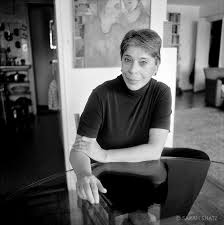Vivian Gornick. Image via sarahshatz.photoshelter.com.
As I mentioned in the previous post, one of the advantages of the workshop format is that it helps students become more critically aware of their own work.
For my writing workshops, I’ve adopted the pedagogy that Vivian Gornick presents in her book The Situation and the Story. One of Gornick’s emphases is the distinction between the writer and the narrator:
The writing we call personal narrative is written by people who, in essence, are imagining only themselves: in relation to the subject in hand. The connection is an intimate one; in fact, it is critical. Out of the raw material of a writer’s own undisguised being a narrator is fashioned whose existence on the page is integral to the tale being told. This narrator becomes a persona. Its tone of voice, its angle of vision, the rhythm of its sentences, what it selects to observe and what to ignore are chosen to serve the subject; yet at the same time the way the narrator—or the persona—sees things is, to the largest degree, the thing being seen.
To fashion a persona out of one’s own undisguised self is no easy thing. . . . The persona in a nonfiction narrative is an unsurrogated one. Here the writer must identify openly with those very same defenses and embarrassments that the novelist or poet is once removed from. . . .
Yet the creation of such a persona is vital in an essay or a memoir. It is the instrument of illumination. Without it there is neither subject nor story. To achieve it, the writer of memoir or essay undergoes an apprenticeship as soul-searching as any undergone by novelist or poet: the twin struggle to know not only why one is speaking but who is speaking.
Vivian Gornick, The Situation and the Story, pp. 6-8
With this in mind, I ask my students to observe the distinction between the writer and the narrator.
Instead of this: “When you escaped the burning building . . .”
This: “When the narrator escaped the burning building . . .”
And instead of this: "When you told your boss you hated your job . . . "
This: "When your narrator told her boss that she hated her job . . . "
It takes the workshop participants a while to get used to this. But as they develop this habit and cultivate awareness of the distance between the writer and the speaker, they bring a keener awareness of this distinction into their own work. Their writing sharpens and sound more real, more vivid, because they are now aware that the speaker on the page does not exist until she has been created by the writer.
The distinction holds across art forms. Though their work speaks for them, it is worth considering the distinctions between . . .
- A composer and the compositional voice in her music.
- A painter and the voice alive on her canvas.
- A dancer and the voice alive in her movement on stage.
- An architect and the voice alive in her design.
In each case, the artist creates a speaker, someone whose sole job is to express the art. Her being does not perfectly overlay the being of the artist. She might do or say what the artist would never think of. The power and freedom she gives to the artist is available only upon recognition of her separate existence.
Thank you for reading.
